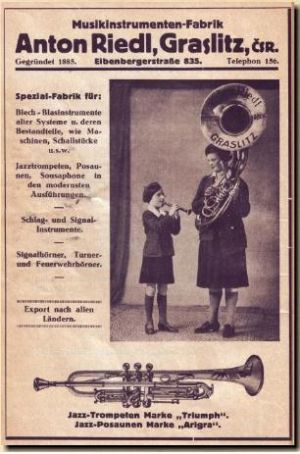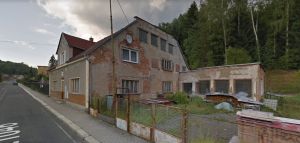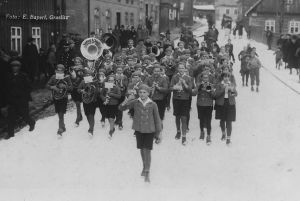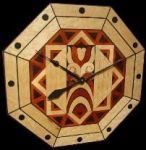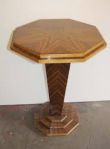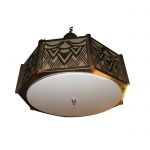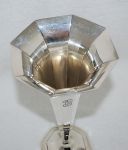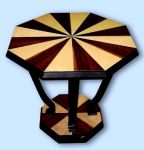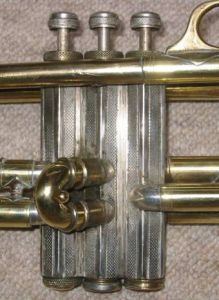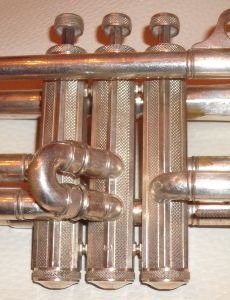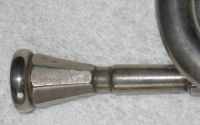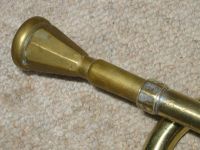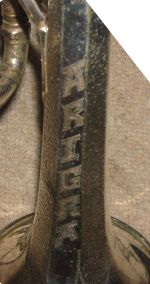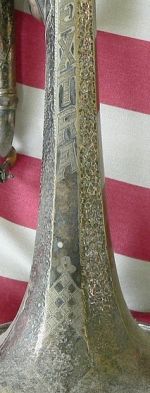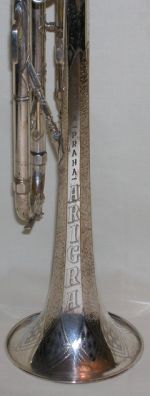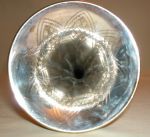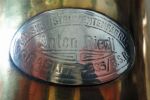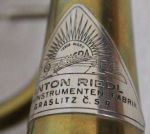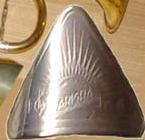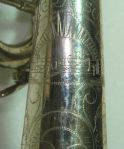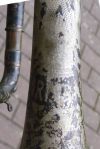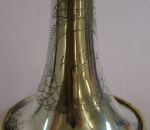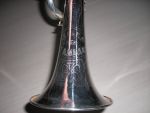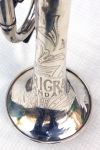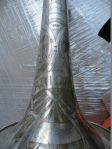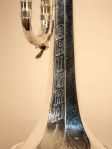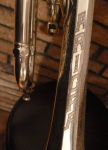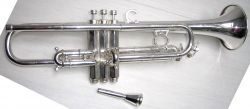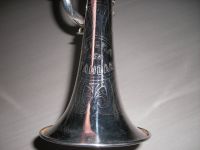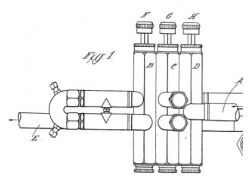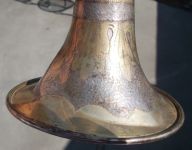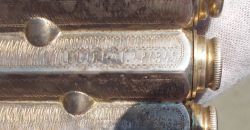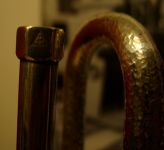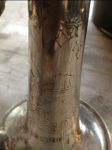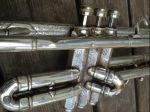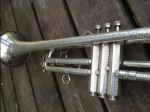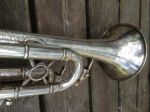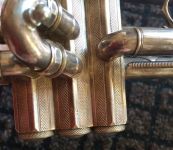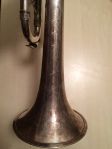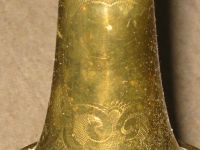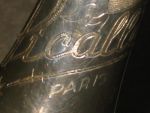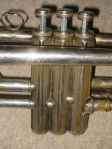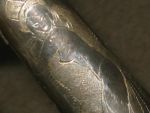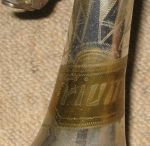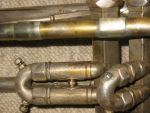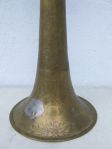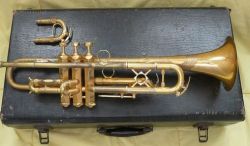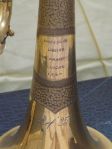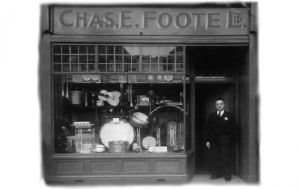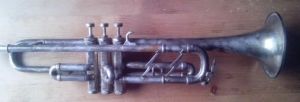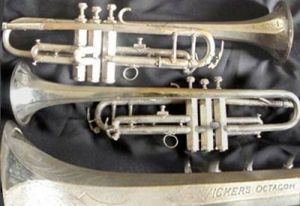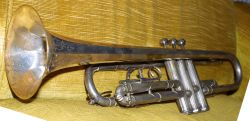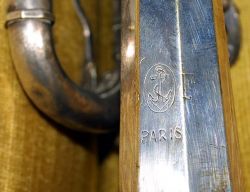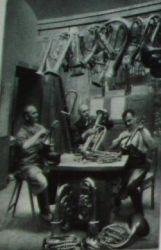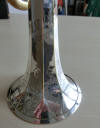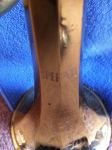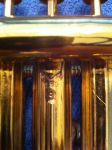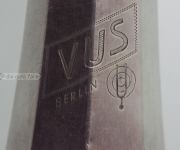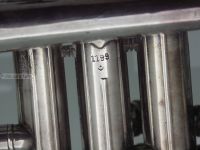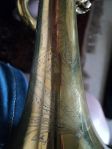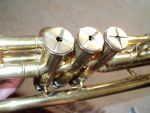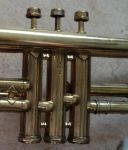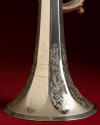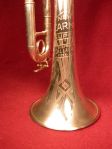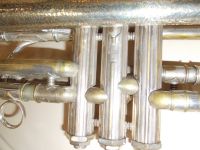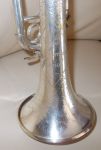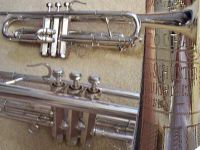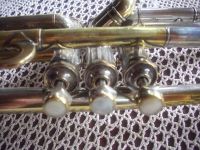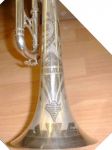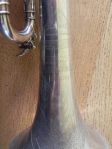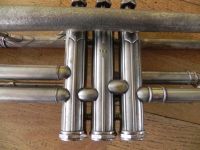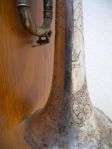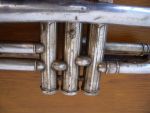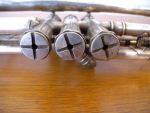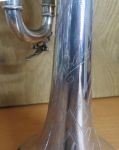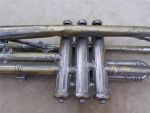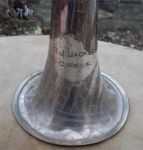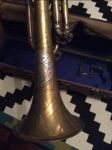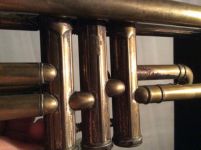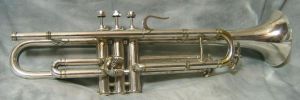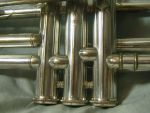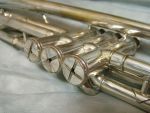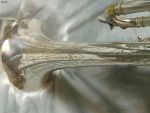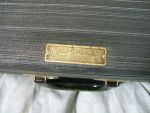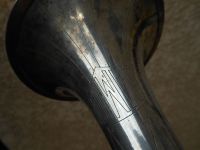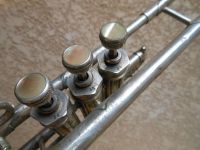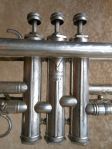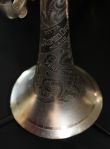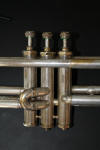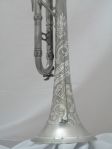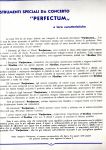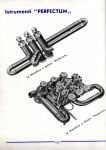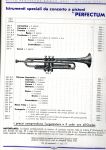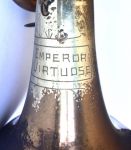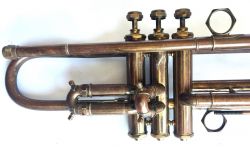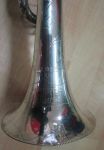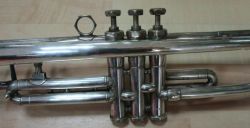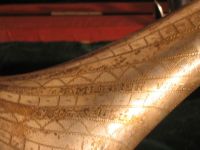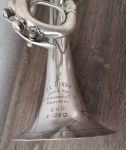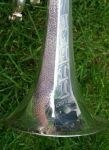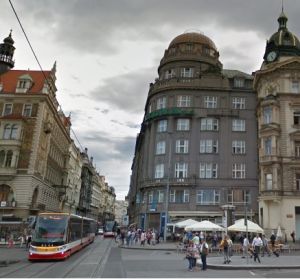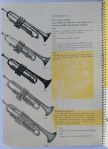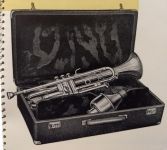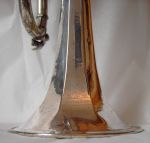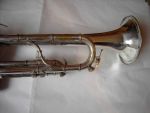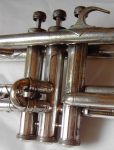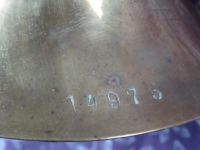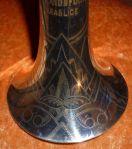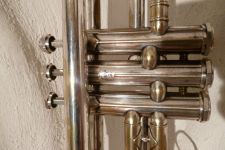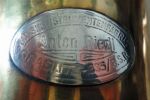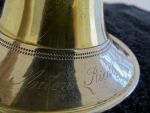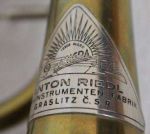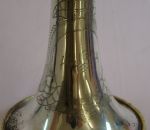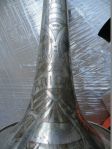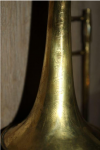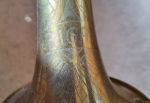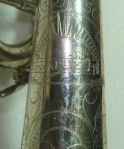Difference between revisions of "Arigra"
Gwesterhof (talk | contribs) m (→Abbott) |
Gwesterhof (talk | contribs) m (→Abbott) |
||
| Line 364: | Line 364: | ||
===Abbott=== | ===Abbott=== | ||
| − | An octagonal trumpet for sale in California is named Abbott. It has a hexagonal valve block like one of the Schuster Aristocrats. There has been an Abbott Manufacturing Company in New York. But the few known Abbott instruments all have 'Mfg Co' on the bell. A | + | An octagonal trumpet for sale in California is named Abbott. It has a hexagonal valve block like one of the Schuster Aristocrats. There has been an Abbott Manufacturing Company in New York. But the few known Abbott instruments all have 'Mfg Co' on the bell. A rare cornet for sale at Ebay has the name 'The Abbott' and 'Prague' inscribed. |
<gallery> | <gallery> | ||
File:Abbott.jpg | File:Abbott.jpg | ||
Revision as of 18:37, 22 November 2021
The Arigra is the most common of the Czech Octagonal trumpets. ARIGRA is an acronym for Anton RIedl GRAslitz.
Contents
Anton Riedl
Anton Riedl was born in 1861 and established his own company in 1885. Riedl was an accomplished maker of brass instruments, (rotary) valve blocks and bells and also a trader of other musical instruments. 'Exporting to all countries', as an ad states.
By the end of the 19th century there were 11 musical instrument factories in operation in Graslitz, employing some 300 workers, and 16 merchants trading musical instruments. Graslitz then was part of the Austrian-Hungarian Empire.
After WWI, Graslitz was part of the new Czecho Slovakian Republik. Production in Graslitz quickly recovered and at a time there were 59 musical instrument manufacturers in the area including such names as Bohland & Fuchs, F.X.Hüller, A.K. Hüttl and Julius Keilwerth. And Musikinstrumenten-Fabrik Anton Riedl, by then located at the Eibenbergerstrasse 835 in Graslitz (now: Wolkerova, Kraslice).
In 1931 Anton reached the age of 70 years as senior chef of his Musikinstrumentenfabrik in full physical and mental health, as the Zeitschrift für Instrumentenbau mentions. Riedl's son Hugo became partner in the Musikinstrumenten-Fabrik Anton Riedl from 17-01-1931 onwards (an OHG, Offene Handelgeselschaft).
From 14-05-1938 Hugo Riedl is registered as the sole owner of Anton Riedl Musikinstrumenten-Fabrik, trade name Arigra. In a list of house owners in May 1945 Hugo is still listed at the address Eibenberger Strasse 835. After WWII the German speaking population was expelled from what again became Czechoslovakia. In a list of German people that were expelled, Hugo is not mentioned, but Anna Riedl (49) is mentioned as owner of a factory, with a husband in Bavaria, departure provided by a train on October 11th 1946.
With the formalisation of the creation of the Amati collective in June 1948 (working back till 1-1-1947) Anton Riedl was one of the confiscated companies and workshops involved.
Although Riedl made other instruments (see below), he's best known for his octagonal Arigra trumpets. Friedel Keim describes them in his book Das grosse Buch der Trompete" as being inspired by the Jugenstil (Art Nouveau) style, the international style of about 1890 until 1914. But most often they are referred to as Art Deco style. Art Deco was a design style popular from approximately 1925 through 1939.
The Arigra: Style and shape
Art Deco
The name Art Deco is derived from the style's origins at the the 1925 Exposition Internationale des Arts Décoratifs et Industriels Modernes (International Exposition of Modern Industrial and Decorative Art) in Paris, although the term "Art Deco" was not commonly used until the 1968 publication of Bevis Hillier's art history book Art Deco of the 20s and 30s.
Art Deco was an opulent and purely decorative style that projected elegant modernism. Much of Art Deco style is based on clean geographic shapes with sunbursts, chevrons, zigzags, and octagons predominating. The increasing dominance of technology is reflected in images celebrating machines like railroads and airplanes. Sweeping curves in buildings reflected new trends in aerodynamic streamline vehicle design. Objects from the natural world (especially eagles) were presented in geometrically stylized designs.
As an aside it must be said that a lot of the horns for phonographs, invented in 1877, also were built with 8 (or more, or less) panels. To be researched a little more....
Another aside is this octagon fire brigade horn that dates from the 1870's already. With the hallmark "CAIRNS & BRO 143 GRAND ST N.Y. PAT'D SEPT. 11 '77", this 8 fluted silver plated trumpet from the "Hibernia Fire Co No. 6 Organized June 10th, 1871" was to be used by the Assistant Foreman.
Fire brigade horn Cairns & Bro 143 Grand Street New York, patented Sept 11 1877
The Arigra octagonal trumpets have to be dated somewhere between 1925 and 1937, maybe even between 1930 and 1937. Maybe Hugo Riedl was the initiator/maker, as his father was in his seventies already by then. This was the period in which also other examples of art deco like trumpets appear on the market. Apart from their octagonal bell, the Arigra trumpets have a lot of art deco style details. There also is a remarkable, not to say incredible lot of variety between the instruments, not in their overall form but in details like the bracing, the engraving, the spins, the valve blocks. That's possibly because they were handmade over a longer period of time, or maybe the parts were sourced from diffferent makers.
Braces
Most often the Arigra's have a hexagonal shaped spin as the main slide brace. But there are also some examples of otherwise formed spins, a double brace and several examples of a single diagonal brace, with different angles.
Valve block
A solid hexagonal valve block is found on part of the Arigra's. The other ones have 'normal' spaces between the hexagonal valve casings.
But there are also Arigra's with fluted casings.
Mouthpiece
An octagonal mouthpiece is part of the original Arigra set up.
Name engraving
Almost all the Arigra's have this shady lettering. The Arigra Extra has 'Extra' engraved instead of 'Arigra' (difficult to see). The difference with the normal Arigra lies in the shape of the spin. And there is an Arigra with an additional 'L. Tůma' engraved. L. Tůma, was a Prague firm, selling, renting and exchanging all musical instruments.
Most of the Arigra's also have engravings inside the bell, reflecting the engraving on the outside. Quite often the bells have handhammered facets.
Logos
The (presumed) evolution of the logos Anton Riedl used. He must have started with 'Musikinstrumentenfabrik Anton Riedl Graslitz 835/Č.S.R. (835 being the address and Č.S.R. referring to Československá republika, the Czecho Slovakian Republik that existed from 1918 till 1939 and from 1945 till 1960). At one point the trade mark Arigra was introduced and the Anton Riedl reference disappears. I guess the organic forms came first and then the more geometrical 'art deco' designs. The variety is fascinating.
Arigra variations, copies and stencils
Arigra Standart
There are a few examples of another Arigra model named Standart. This model has a round bell but quite some octagonal and hexagonal details in common with the octagonal model, like the valve casing, ferrules. It might be a precursor to this model, or a 'light' version. The model name, Standart instead of Standard, must be a statement....
An Arigra Standart sold on Ebay December 2014 has on the middle valve a reference to a Britisch patent, numbered 486345.
That patent, BRIT. PAT. 486345. was applied for on March 17th, 1937 by Heinrich Hermann Dick from German Markneukirchen. It refers specifically to the hexagonal valve casings and the solid valve block, and also mentions the valve heads being screwed inside the valve casings and the pistons provided with a projection registering in a groove in the casing.
Heinrich Hermann Dick was the son of trumpet maker Heinrich Dick. Heinrich Dick in 1848 established a dealership for brass instruments in Markneukirchen which was expanded into a manufacturing and exporting company for musical instruments and accessories by his son. As a mail order firm they traded mainly string instruments. In the thirties all other instruments were added, as were mechanical instruments. The conclusion must be that Dick tried to market the Arigra instrument in Great Britain. A similar instrument was offered in September 2013 on Ebay with an asking price of $12.000. It didn't sell...
The hand hammered instrument with silverplating and gold wash has the name VOSCH engraved on the bell. The same Britisch patent number is engraved: BRIT. PAT. 486345. There's a similar Vosch in the Musikinstrumenten-Museum in Berlin. Another Vosch, owned by Daniel Becker from Essen (G) is pretty much the same. Remarkable difference: it has 'Patent regd. 7733' on the valve block. Not clear what that means, as it's a pretty low number for German, UK or US patents.... The valve is marked 13. On the mouthpiece reciever of this Vosch there's a styled AR, suggesting again Anton Riedl as the maker. Which makes me think that Vosch might be a trade name.
Broadway
A Broadway, that was sold on the American market also looks pretty much the same. This instrument was sold in 2014 on the Swedish auction site Tradera. Hexagonal valve casings, thumb ring, ferrules and an octagonal spin, all like the Hermann Dick/Arigra/Vosch instrument. It looks like on the bell there's written 'American Model' and 'The Best of the World'.
And here's an Arigra trumpet with solid hexagonal valve block and round bell with 'Arigra' on that bell, with the hexagonal spin.
Below is a trumpet with all the typical Arigra features, again without the octagonal bell. The bell has no makers name but the logo frame is identical to one of the Arigra logo's above.
The next trumpet has similar features, this time with the logo FK on the bell.
Trumpet with hexagonal valve casings marked FK. Source ebay.com 2020
Picalle Paris
A similar trumpet with a typical 'Arigra' valve block, hexagonal spin and thumb ring and two digit number on middle valve, engraved 'Picalle Paris' as well as a naked lady. Detail: the spin is not on the extension piece..
Anton Riedl Triumph
A trumpet with a hexagonal valve block was offered on Ebay.de in 2015. It's engraved 'Triumph' and has a lot of hexagonal details. In an early ad, Anton Riedl advertised 'Triumph' as his jazz trumpet brand, aside from his 'Arigra' jazz trombone. This is definitely an (early) Riedl. The valve caps and bottoms are hexagonal instead of the round ones that are found on the Arigra trumpets. These hexagonal valve caps and bottoms can be found on a lot of other trumpets with hexagonal valve casings as well. Which leads me for now to the hypothesis that they all originate from the same valve block maker.
AK Hüttl Kraslice
The above trumpet is marked AK Hüttl Kraslice. Anton Konrad Hüttl (started his workshop in 1877, in 1935 some 40.000 brass instruments a year were made. Together with Bohland & Fuchs Hüttl took care of 60% of the Graslitz export of brass instruments. And like B&F the firm was confiscated in May 1945, and became part of the Amati collective. Hans Hüttl worked from 1947-1954 in South Wales were Boosey and Hawkes gave him the opportunity to look for new export markets. This trumpet is also not octagonal but hexagonal in it's details. The valve casings are marked 49, 50, 51. What's interesting is that it reads Kraslice instead of Graslitz, suggesting that it was made after WW II and somewhere before the start of Amati (although there seems to have been a transition period in which names like Bohland & Fuchs were used in combination with the Amati label). It looks however very much like the above Triumph and 'pre-war. And the name Kraslice was also in use between the two wars for non-export production.
Zolena (?)
This trumpet offered on Ebay in 2013 also has hexagonal valve casings and other hexagonal details and a hammered bell. The valve block is not of the solid type. Probably pre WW-II, the engraving is difficult to read, the seller's estimate is 'Zolena'. It looks a lot like the above Triumph and the AK Hüttl, obviously missing the piece with the spin that would make it play in Bb.
Chas E. Foote, London
A more or less identical trumpet is engraved "Chas E. Foote" and "Ref '25'". Charles Edward Foote opened a music shop in 1920 at 232 Hornsey Road, London. It relocated to Soho in the 1930's. It has the same hexagonal valve caps and bottoms as the Thriumph and the Hüttl. This instrument also seems to be missing the piece that makes it play in Bb, it's handhammered and has a rimless bell like the Zolena. Foote's instruments are often marked Ref, Super Ref or Ref Streamline.
My hypothesis is that it has the same Graslitz origin as the above trumpets, underlined by the next instrument with a serial number one up. It has that typical Graslitz spin in the part that makes it play in Bb.
Boosey and Hawkes New Century
A trumpet with hexagonal valves, valve caps and bottoms, an edgy pinky ring and lightning flash braces. The engraving says New Century Boosey & Hawkes Ltd 295 Regent Street, London W 1. Probably made in the 1930's (in any case after the merger of Boosey and Hawkes in 1930). It does not have the normal, and well documented B&H serial number. Nor are the valves numbered (with the serial) as they normally are on instruments from this company. In 2012 a British seller of a New Century has contacted Bradley Strauchen, a curator at the Horniman Museum where they keep all the B&H records, they have been unable to find any direct reference to the instrument at all and no trace of its manufacture. They both felt that it looked similar to models being produced in Czechoslovakia in the early thirties. Conn in the US had also brought out a tight wrap trumpet at this time so it was a bit of a fashion thing. They also felt that the date of manufacture is almost certainly the 1930's.
Vickers Octagon
On Horn-u-copia.net there's a Vickers Octagon, with serial number 2025. The seller dated it between 1925 and 1935. The origin is unclear. One possibility is that it was imported by J.J. Vickers and Sons, who early into the 20th century had become the principal importer of musical instruments in the UK, offering concertinas and everything else except pianos. But that's just a wild guess. Another clue might be a trumpet, offered on Ebay Germany in 2020, that is engraved Vickers London, with a bill dated 29-9-1952.
Bohland & Fuchs
Bohland & Fuchs
The trumpet below is made by Bohland & Fuchs. Bohland and Fuchs are established as a partnership in 1870, following the firm of Gustavus Bohland, which had been founded 20 years earlier, and flourished until 1945 when the firm was nationalized. By 1925, they had a workforce of 500. They were the first to use steam engines in their factory before WWI. Before WWII Bohland & Fuchs was one of the main brass instrument factories in Graslitz. During the war most factories were in the war industry. After the war, the production facilities of firms like B&F, Kohlert, Keilwerth, Hüller were merged into the AMATI cooperative (and in 1948 nationalized). So I guess the Bohland & Fuchs instrument will be pre-war. The instrument is engraved with the B&F logo and 'Paris' and a serial number 955 on the middle valve housing (with an anchor under the number, a typical feature for B&F instruments). All three of the valves also are marked with "955" (and with 1,2,3 respectively).
An almost identical trumpet, engraved Const. Riedl Nürnberg also has a small (B&F) anchor on the valve block and serial number 1219. Konstantin Josef Riedl (Nürnberg 22-6-1869 - 19-1-1950) established his workshop in 1883. His son Konstantin Richard Riedl (Nürnberg 31-3-1900 - ? ) started in 1925. In 1930 the workshop was located at the address Hintere Kartäusergasse 5, according to the 'Buch der alten Firmen der Stadt Nürnberg' from that year. That's also the address that's on a logo in the case. The address doesn't exist any more, maybe it disappeared in the WWII bombings that destroyed 80% of the Nürnberg centre. Riedl also is known as an instrument trader.
Another trumpet, bearing the B&F anchor with serial number 793 has the name Imperator engraved
And this octagonal bell B&F trumpet with serial number 1199 bears the name VUS Berlin.
Another VUS Berlin trumpet (no octagonal bell), also with the B&F anchor and serial number 391, has the 'Arigra spin', fluted valve casings, octagonal/hexagonal valve caps and bottoms, with the downside of the bottoms similar to the Eugene Schuster Majestic Aristocat (see below).
V.F. Červený & Synové
A 1920's to 30's V.F. Červený & Synové Art Deco Trumpet was offered september 2011 on Ebay by a Canadian seller. It has a octagonal and rimless bell, 8 vertical ridges on the valve casings and hexagonal valve caps and bottoms.
It is engraved with the name of the Czech brass manufacturer V.F. Červený & Synové (Červený & Sons) from Hradec Králové ('castle of the queen'). The seller identified it as an Bohemian made Bohland & Fuchs (B&F) horn, due to the ship anchor stamp on the second valve. There is also a serial number 1459 located. The seller believed the instrument was probably manufactured as an unadorned stencil by B&F in Graslitz, and then finished in Hradec Králové. There was quite a free exchange of ideas, patterns, and parts in Bohemia and Vogtland in these days. A customer of Czech origin stated that the engraving pattern on the bell is common to Czech painted and etched glass and crystal.
Dearman, London
Dearman is a trademark of John E. Dallas & Sons, who distributed the Czech B&F trumpets under the names Dearman Master, New Special, New Super. Octagonal and hexagonal details, art-deco engraving, it's all there. The bell also says 'foreign', which confirms that it's produced outside Great Britain.
Eugen Schuster, Markneukirchen
The University of Edinburgh has a Eugen Schuster Aristrocrat trumpet with a hexagonal valve block. Eugen Schuster was a trader in Markneukirchen, trading instruments under his trade mark Majestic Aristocrat and also Buescher and Selmer instruments. He built saxophones, between ca 1937-1951, but no brass instruments.
HUC also features an Eugen Schuster Majestic Aristocrat with a hexagonal valve block but with different brace, stating that Schuster was a dealer from 1928-1932. The New Langwill Index lists Schuster as being active between 1925 and 1932.
The Majestic Aristocrat also came in a version with fluted casings, like the above mentioned Bohland & Fuchs instruments. This B&F instrument has serial number 491.
This Majestic Aristocrat engraved trumpet also has a rimless bell. It has serial number 476 and a small anchor below the serial number indicating Bohland & Fuchs as maker of at least the valve block. The number 476 is also found on the upper and bottom valve caps, the hexagonal valve casings are numbered 1,2,3. Under spring valves, octagonal valve caps and hexagonal valve buttons. The pinky ring and spin are resembling the Arigra.
And this Schuster Majestic Aristocrat has fluted casings, serial 780 but no B&F anchor
The different valve blocks suggest that Schuster sourced his trumpets from Riedl as well as from B&F.
Abbott
An octagonal trumpet for sale in California is named Abbott. It has a hexagonal valve block like one of the Schuster Aristocrats. There has been an Abbott Manufacturing Company in New York. But the few known Abbott instruments all have 'Mfg Co' on the bell. A rare cornet for sale at Ebay has the name 'The Abbott' and 'Prague' inscribed.
Abbott octagonal trumpet, source ebay.com 2021
Princess
A pretty much similar trumpet with also a rimless bell is this one engraved Princess. Its has the numbers 108 and 461 on the middle valve. The downside of the valve bottoms is similar to the one thet are found one the Schuster Majestic Aristocrat.
Roland
This Roland has serial number 968 and the B&F anchor.
R.J.Jackson Omega
A wrecked trumpet marked R.J. Jackson Omega popped up on Ebay UK in december 2014. It has octagonal valve caps and bottoms, octagonal B&F like ridges, a Arigra Standart-like spin and art deco engravings.
J Steijn Zaandam Imperial
Another B&F stencil with fluted casings and 'Arigra' spin, serial number 536, marked Imperial and traded by Dutch music shop J. Steijn in Zaandam.
Rolls Diplomat
The Rolls Diplomat and the Super Rolls Diplomat are also trumpets with fluted casings and a lot of art deco details. Trevor Jones who offers one for sale states that they were probably made by Bohland & Fuchs for Selmer. Several cases say Rolls Diplomat Handcraft Instruments, 8, Moore Street London W. Which is close to 12, Moor Street where Ben Davis is said to have started Selmer London back in 1929 when he secured an agency deal to sell saxophones supplied by the French company Selmer. In 1937 they moved to 114-116, Charing Cross Road, a few minutes walk. (Other sources say however that Ben started at the 1st floor of 126, Charing Cross Road and moved to 114-116 in 1932...) None of the Rolls Diplomats I've seen have the typical B&F anchor however, most of them have a double figure serial number which isn't typical for B&F either. Most of them have the engraving Foreign on the middle valve casing, indicating that they were made outside of the UK.
The valve bottoms however resemble those on the Eugen Schuster Aristocrat, that were made in Graslitz.
Couesnon Paramount
A Couesnon Bb/C trumpet with hexagonal valve slide knobs, valve bottoms and 5 ridges on the valve casings and a art-deco'ish geometrical design on the bell. The valve casings remind of Bohland & Fuchs.
Romeo Orsi
A similar valve block with the vertical ridges on the valve casings and a lot of other 'art deco' details are found on this trumpet engraved Ditta Prof. Romeo Orsi Milano Perfectum. It has a rimless bell. The spin slightly differs from the above ones.
Ditta Prof. Romeo Orsi Milano Perfectum. coll. Robert Woodruff, Pennsylvania US, before restauration (above) and after (below). Pinky hook and 3rd valve slide ring added, valve bottoms replaced with hexagonal ones
Romeo Orsi (1843 - 1918) was a clarinettist and an instrument maker in Milano. As of 1918 the firm was called Prof.Romeo Orsi. Ditta is the italian word for company and Perfectum was the top line of their instruments, in a constructional and esthetical way.
This instrument is featured in the 1938 Orsi catalog and shows a hexagonal spin, braces, ferrules and valve tops, octagonal valve caps and bottoms. The instruments labelled "Perfectum" were top quality production of Orsi and included woodwinds as well as brass winds. It's an instrument not produced for many years since it's not in the 1932 catalog and disappears in the later catalogs. The similarities between the valve blocks of the Červený, B&F, Lignatone and Orsi instruments could indicate they came from the same valve block maker.
Emperor Virtuose
Another trumpet with octagonal valve caps and bottoms, fluted casings and a lot of hexagonal details, sold from New York and engraved Emperor Virtuose. The seller states that the valve casings are numbered 7,8,9 and dates it in the 1930's, which I think is correct.
Emperor Virtuose is a French brand by Dolnet from Paris.
Here's another Emperor Virtuose that is marked Chicago USA and has hexagonal valve casings.
Another Emperor Virtuose was imported and sold onder the sub name Le Berry by the Canadian music house of Edmond Archambault in Montreal. As it is marked Ed.Archambault Inc. it must be dated 1928 or later. The other marking on the bell DND K1080 is probably added by the orchestra it was used in.
Emperor Vituose Le Berry, vendu par Ed. Archambault Inc. Montréal
Arigra after WWII
Amati
After World War II, in September 1945, musical instrument manufacturers in Kraslice merged on 17.10.1945 into a cooperative that was given the name "AMATI" (now: Amati-Denak). One of them was Anton Riedl. In 1948, the cooperative was nationalized. Some other firms incorpororated were F.X. Hüller & Co, Josef Glassl, Bohland & Fuchs, Julius Keilwerth, A.K. Hüttl, Franz Michl and Kohlerts Söhne. An octagonal Amati trumpet was offered in 2013 on the German auction site Quoka. It's identical with the pre-war Arigra's, even in the lettering.
That the Arigra was marketed after WWII also becomes clear in a Ligna catalog that is directed to the Latin American/Spanish market. Ligna (latin for wood) was a trade company for (mainly) the export and import of wood and wooden products, founded in 1949. As the catalog shows, it had a department for musical instruments, the catalog showing mainly brass instruments (but also clarinets, bassoons and oboes). On the backside of the cover the brands Cremona (for guitars), Amati (for brass) and Melodia (for accordeons) are mentioned. The saxofones are branded Toneking, which implies that the catalog dates before 1955 (that year Amati had to stop using this brand in favor of Keilwerth).
In this Ligna catalog the Arigra trumpets have a separate entry and are advertised as 'especially for jazz band musicians'. Two models: the Arigra Standard with the one piece valve block and the Arigra Luxus.
The Arigra Luxus is stated to be identical to the 'Paris' model in the same catalog, although the last one has a S shaped brace instead of the Arigra spin and also the pinky hook is a traditional one. The Paris has side operated spit valves, as has the Paris model from Bohland & Fuchs above with serial 955.
Amati Lignatone
This Lignatone octagonal trumpet below also is a post war Amati instrument. Lignatone is a trademark that was used by the state owned AMATI company after WWII for Czech export horns and other instruments.
It's pretty much identical to the pre-war B&F octagonal trumpets.
The typical Arigra spin and valve caps along with some octagonal ferrules are also found on this Amati from Kraslice. Here the valve casings have the vertical ridges that are seen on the Bohland & Fuchs trumpets (that also was incorporated in the Amati collective).
And a similar Amati with a rimless bell and serial number 14975:
This Bohland & Fuchs trumpet with serial number 1469 also has a rimless bell. And it has this typical 'Arigra' spin. It's engraved Kraslice, the Czech name of Graslitz.
And it's identical to this trumpet in the above mentioned Ligna catalog, model number 3000. For jazzband, 'model for virtuosos'.
Other Instruments by Anton Riedl
Although Anton Riedl is best known for his octagonal Arigra trumpets, he made/sold other instruments as well. For instance the sousaphone shown in the first paragraph. There are not many of Riedl's instruments known to be around, but there's quite a variety. Some examples:
Czortków is a Polish village: https://en.wikipedia.org/wiki/Czortk%C3%B3w_uprising
The first trombone has the vertical lettering, the other two are horizontal. All have hexagonal details.
The Exakta
So far for the Czech/Graslitz related instruments. Now over to Markneukirchen and the Exakta.
Other trumpets with hexagonal valve casings
Click on the following title to view an overview of Other trumpets with hexagonal valve casings
Overview of Arigra's around
| There are quite some octagonal Arigra's around. Sven Grosch states there were some 2500 made, I don't know where that figure originates but it could be true. Some 90 are listed below. | ||||
|---|---|---|---|---|
| nr. on valve block | remarks | picture | picture | source |
| 1A | Coll. Markus Wieghaus, Oldenburg Germany | |||
| .1 | from coll. Eric Totman US | |||
| 2A | ebay sale from Germany 2013 | |||
| 3 | for sale by Zetka, Prague, CR in 2011 | |||
| 3? | B on receiver | ebay sale by riomar6 Bulgaria | ||
| 4 | ebay sale by karolamoldzavodny, Oslo, Jan 2015 | |||
| 8A | ebay.de sale by nonnenrutsche, Hessen, 2021 | |||
| 8A | coll. Jerome Davies UK | |||
| 12A | coll. Jerome Davies UK | |||
| 13 | 13 on the first valve casing (that's further smooth) | aukro sale april 2014 | ||
| 13 | 13 on middle valve casing and under valve cap, 9 K on mouthpiece reciever | for sale Ebay.com by Hyges, Dec 2014 | ||
| 14A on the middle valve | ||||
| 19? | 'ca 1937' silver and gold plated | coll Heikki Moisio, Turku Sweden | ||
| 23? | B on receiver | ebay sale by g.mu6 Germany in 2011 | ||
| 24A | octagonal valve block, round bell | martmart1 | ||
| 27? | for sale from Czech Republik | |||
| 34 | for sale Ebay by g.mu6 Aug 2017 | |||
| 34A | for sale on Marktplaats.nl jan 2018 | |||
| 35 | ebay sale by erbgemma 2013 | |||
| 36 | 36 on the first valve and middle valve casing | coll. Bob Woodruff | ||
| 36 | 36 on the middle valve casing and on valves | coll. Jos Weeland | ||
| 37? | for sale on Ebay.com by jropeman10 nov 2014 | |||
| 38 | coll. Gerard Westerhof Netherlands | |||
| 38 | for sale ebay.de 2018 | |||
| 45 | ebay sale from Norway by kyndovaz dec 2013 | |||
| 45 | coll Dieter Grosche, Dusseldorf, Germany | |||
| 46A | for sale ebay.de by allerleivonmir2016 jan 2018 | |||
| 47 | 47 on the middle valve casing | ebay sale from musicshop72 in Brno June 2017 | ||
| 50 | coll Dieter Grosche, Dusseldorf Germany | |||
| 57? | ebay sale by g.mu6 Germany in 2009 | |||
| 57? | ebay sale from Czechia by jropeman10 in 2014 | |||
| 59 (?) | for sale on Ebay by g.mu6 Germany in 2014 | |||
| 83 | for sale by Eric Totman US in 2009 | |||
| 94 | B b on reciever. Before and after restauration by Rick Ita | coll. Robert Adams, Atlanta US | ||
| 9x | for sale by gebrauchte-blasinstrumente.eu feb 2016 | |||
| 107 | 107 on middle valve casing and on all the valves | coll. John C. Hallam UK | ||
| valves and valve casings marked 10, 11, 12 | for sale by Steve Ward, Quinton, US in 2015 | |||
| 13, 14 A, 15 on valves | for sale in July 2014 Prague aukro.cz | |||
| valves marked 16, 17 A, 18 | coll. Dieter Grosche, Dusseldorf Germany | |||
| 15, 19, 19 on valves '1930's?' | from coll. Eric Totman | |||
| 28, 29, 30 on valves and valve casings | for sale in Jan 2015 Ebay.de blechjeck13 | |||
| 52, 53, 54 on valves | for sale Dec 2014 Ebay.de dr.m._de | |||
| 79, 80, 81 on valves '1920- 1930' | coll. M.Rippert, Germany | |||
| for sale from Russia | ||||
| for sale from Oslo, Norway | ||||
| A13 on backside of first valve '1925' | sold in 2010 from Augsburg, Germany | |||
| coll. Sven Grosch Germany | ||||
| for sale 2013 at Nastroje Hudebni, Czech Republic | ||||
| ebay sale by g.mu6 Germany in 2009 | ||||
| for sale by Czech seller | ||||
| nr ? | sold in 2011 through Lauritz.com Danmark | |||
| 'ca. 1925' | coll. Phil Holcombe, St Pete Beach Florida | |||
| Arigra L.Tůma Praha | coll. Robert Adams, bought Eric Totman US | |||
| no nr. | ebay sale by g.mu6 Germany in 2009 | |||
| Arigra Extra US | sold by Quality Brass, Iowa US in 2011 | |||
| sold through Szabar, Czech, in 2012 | ||||
| B on receiver | ebay sale by g.mu6 July 2013 | |||
| ebay sale by g.mu6 Oct 2013 | ||||
| new reciever, double brace, one missing | 2013 and again Feb 2014 | |||
| for sale from The Netherlands | ||||
| for sale in 2008 by Tony Bingham UK | ||||
| dated 'around 1940' by the Museum | coll. Germanische National Museum, Nurnberg | |||
| coll. Ptuj Ormož Regional Museum | ||||
| from picture gallery Yorkmaster | ||||
| coll. D. Antonio José Ortega Bernal, Spain | ||||
| '1895/1905' | coll. Musikinstrumenten-Museum des Staatlichen Instituts für Musikforschung Berlin | |||
| for sale in 2014 on Tablica.pl | ||||
| 45? | no Arigra name on bell or elsewhere | for sale april 2014 Ebay Germany | ||
| '1920 - 1930' | coll. M.Rippert, Germany | |||
| A | for sale July 2014 Ebay.de g.mu6 | |||
| for sale September 2014 Aukro.cz Oldrich50 | ||||
| for sale September 2014 Aukro.cz bibi09 | ||||
| for sale September 2014 Aukro.cz Vodnikovic | ||||
| for sale Okt 2014 Ebay.co.uk g.mu6 | ||||
| for sale Nov-Dec 2014 Ebay.com g.mu6 | ||||
| for sale Feb-March 2015 Ebay.com by andrejkocis | ||||
| for sale June 2015 Ebay.es lasercorte | ||||
| for sale Aukro.cz nov 2015 Jika1234 | ||||
| Engraved 'Tužkař I-22' | for sale Aukro.cz April 2016 jankov1234 | |||
| for sale Aukro.cz May 2016 modryslonik | ||||
| for sale Aukro.cz November 2016 dave194 | ||||
| for sale Aukro.cz Januar 2017 profesor615 | ||||
| for sale Aukro.cz June 2017 KarelHrdy | ||||
| for sale Oct 2017 olx.com.br | ||||
| coll. The Met, gift from fam. Strauchen 2016 | ||||
| for sale ebay Jan 2018 gmu6 | ||||
| found at www.trumpet-history.com/VirtualMuseum.htm | ||||
| sold through Auktionshaus Mehlis | ||||
| coll. Schloss Kremseg | ||||
Sources
- G.Dullat Der Musikinstrumentenbau und die Musikfachschule in Graslitz von den Anfangen bis 1945
- The New Langwill Index
- Ebay and the rest of the internet

